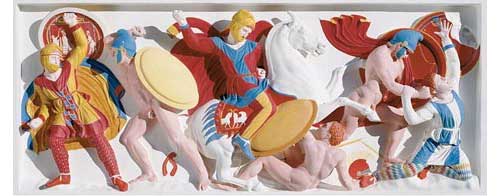Everything You Know is Wrong: Ancient Sculpture was Colorful
September 30, 2010
We all know that Nero did not fiddle while Rome burned – the fiddle wasn’t invented for another 1,500 years for one. Two, although he was generally considered one of the worst administrators among Roman emperors, he was tireless in his efforts to help his subjects after the disastrous fire in 64 A.D.
Nero was vacationing in Anzio away from the summer heat of Rome when he was first informed of the great fire. When he arrived the conflagration was so wide spread the horses he and his guards rode refused to enter the city.
“Speckled with soot, the emperor’s famous bronze hair appeared black; in the thick smoke he was virtually unrecognizable. Nero dashed from street to street, assisting the injured, offering aid, and even entering a burning building to help rescue a family. A man who did not recognize the emperor was so grateful for his help that he offered him a reward of gold coins. Nero declined the reward and revealed his identity to the startled man.” – William Weir, History’s Greatest Lies
We also all know that ancient Greek and Roman statues were white, if marble or bronze colored, if made of bronze. Well, we are all wrong. ColourLovers reveals here that researchers like Vinzenz Brinkmann now believe that mineral and organic pigments were used to paint bright colors on statues and bas-reliefs.
An exhibition in support of these findings, ‘Gods in Color: Painted Sculpture of Classical Antiquity’ features more than 20 full-size color reconstructions of Greek and Roman works, alongside 35 original statues and reliefs. is running at Harvard University’s Arthur M. Sackler Museum in Cambridge, Massachusetts.
I was right! Everything I knew was wrong!
Comments
Got something to say?
You must be logged in to post a comment.


